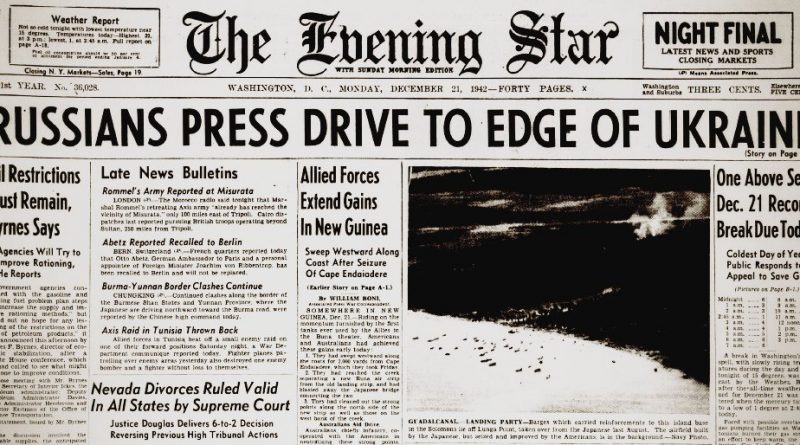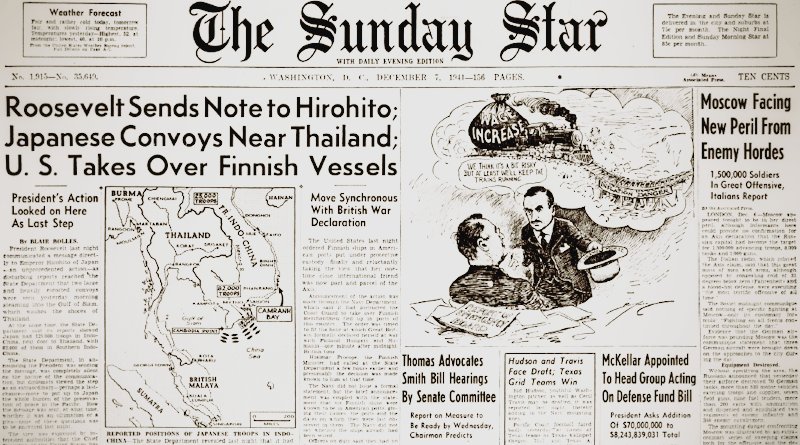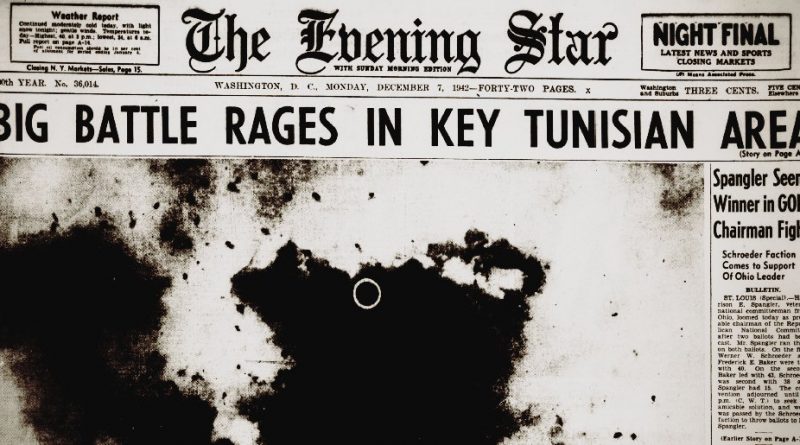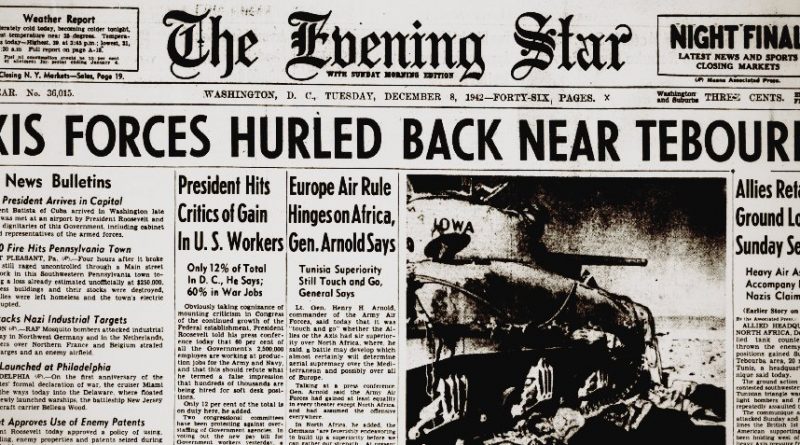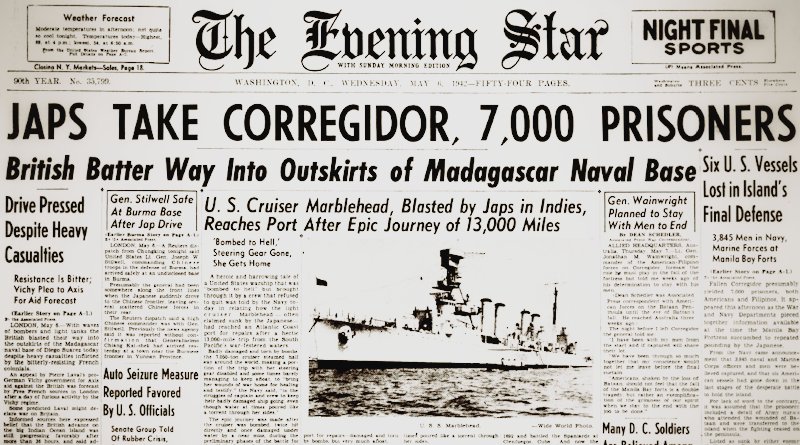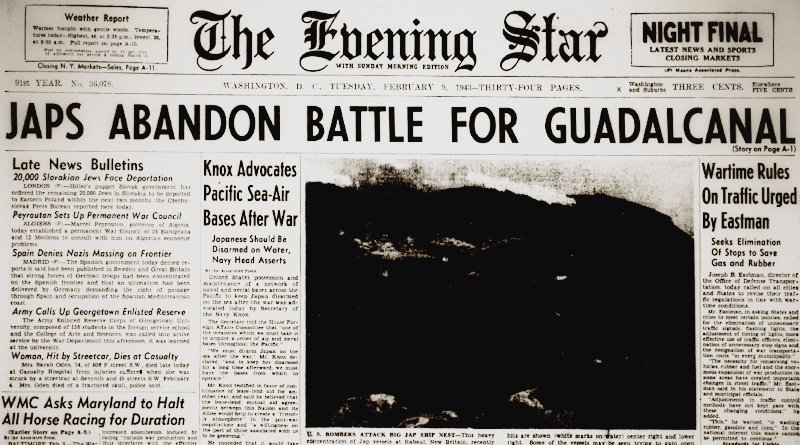World War II Chronicle: December 21, 1942
Click here for TODAY’S NEWSPAPER
King George is pictured with Lt. Robert P. Riordan inspecting a heavily damaged B-17 named Wahoo. The article tells how much damage Riordan’s Fort took and still brought the crew back. Riordan flies 51 combat missions during the war and retires as a colonel…
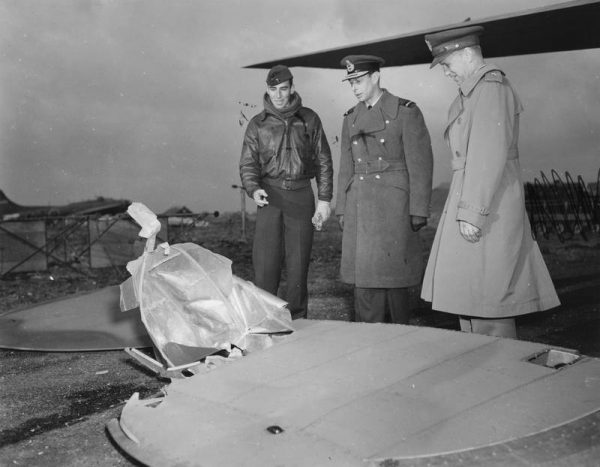
Lt. Col. James Roosevelt is pictured on page six being decorated with a Dominican Republic medal for valor. Pres. Roosevelt’s eldest son participated in the Makin Island Raid while serving with the 2nd Raider Battalion and is currently commanding the newly formed 4th Raider Battalion…
Capt. Jerauld Wright, who participated in the submarine operation to land Gen. Mark Clark on North Africa prior to the Operation TORCH landings, has conducted another daring sub mission. HMS Seraph, the same boat that ferried Clark in October now masquerades as USS Seraph to not offend delicate French egos, is used by Wright to extract French general Henri Giraud from Toulon. Prior to slipping out of his own country, Giraud escaped German captivity twice. He suffered serious wounds and was left for dead after leading a North African Zouave bayonet charge during the First World War. Picked up by the Germans, he was one of the Allied prisoners who the famous nurse Edith Cavell helped escape from Belgium. While commanding 7th Army before France surrendered to Germany in 1940 he was on a reconnaissance patrol of the front. The Germans captured him and sent him to to Königstein Castle, which had been converted to a high-security prison, but he managed to escape by descending a 150-foot-long handmade rope. Giraud made his way to Switzerland, then returned to Vichy France in April 1942, who kept his location secret from the Germans…
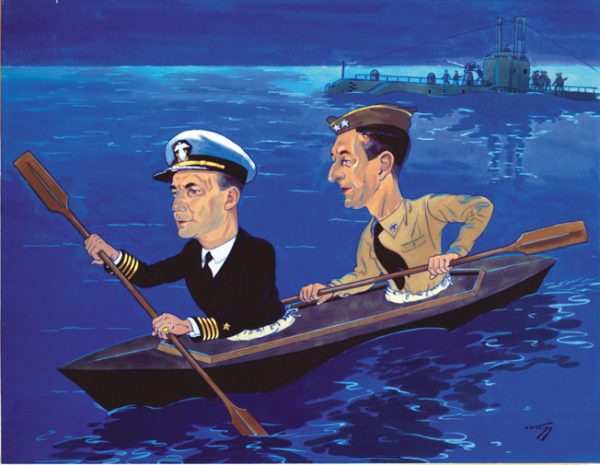
Capt. Wright was the youngest-ever Annapolis graduate (Class of 1918) and conducted anti-submarine patrols on a Mediterranean gunboat during the First World War. He served as Naval aide to Pres. Calvin Coolidge and Herbert Hoover and commanded the battleship USS Mississippi before he was reassigned to help plan TORCH. In 1943 he ships off to the Pacific and will command an amphibious group and a cruiser division and participates in the Kwajalein, Saipan, and Okinawa campaigns along with the battles of the Philippine Sea and Leyte Gulf. Wright will command the U.S. Atlantic Fleet commander and is also NATO Supreme Allied Commander in the Atlantic. After retiring as a four-star admiral, he is named ambassador to Taiwan…
An article on page 10 says that, considering successes in the Solomon Islands, the battleship might still be combat effective. Also mentioned is a Montana-class “super battleship.” These proposed ships would be slower, more heavily armed, and better armored than the Iowa-class “fast” battleships currently under construction. Iowa and New Jersey have already been launched and are commissioned next year…. Sports section begins on page 18 and features a column by Grantland Rice. Rice feels that Sammy Baugh, quarterback of the NFL champion Washington Redskins, has been snubbed by sports writers and deserves to be named the best athlete of the year…
Page 18 also mentions that two undefeated teams, the Second Air Force Superbombers and the Hardin-Simmons Cowboys, will face each other in the Sun Bowl on New Year’s Day. Second Air Force, which plays at Fort George Wright (Spokane, Wash.), is the one of two undefeated service academies and the only one to appear in a bowl game this year. Although not nationally ranked (service teams will be included in AP polls starting next season), they played No. 12 Washington State to a 6-6 tie.
1942 AP Service Poll (Dec. 2, 1942)
| Rank | Team | Record |
| 1 | Great Lakes Navy Bluejackets | 8-3-1 |
| 2 | Iowa Pre-Flight Seahawks | 7-3 |
| 3 | Georgia Pre-Flight Skycrackers | 7-1-1 |
| 4 | North Carolina Pre-Flight Cloudbusters | 8-2-1 |
| 5 | Saint Mary’s Pre-Flight Sky Devils | 6-3-1 |
| 6 | Jacksonville NAS Flyers | 9-3 |
| 7 | Camp Grant Warriors | 4-5 |
| 8 | Pensacola NAS Goslings | 3-5-1 |
| 9 | Manhattan Beach Coast Guard | 6-0-1 |
| 10 | Corpus Christi NAS Comets | 4-3-1 |
| 11 | Second Air Force | 11-0-1 |
| 12 | Fort Knox Armoraiders | 2-6 |
| 13 | Lakehurst NAS Blimps | 4-4-1 |
| 14 | Fort Monmouth Signalmen | 5-2-2 |
| 15 | Fort Riley Centaurs | 6-3 |
| 16 | Camp Davis Fighting AA’s | 4-3-2 |
| 17 | March Field Flyers | 5-2 |
| 18 | Fort Totten Redlegs | 3-5-1 |
| 18 (tied) | Spence Field Fliers | 0-4 |
| 20 | Camp Shelby Cycloners | unknown |
| 20 (tied) | Fort Douglas MP’s | 5-3 |
| 20 (tied) | Daniel Field Eagles | 0-6 |
The Superbomber backfield includes two former NFL backs, the Green Bay Packers’ Hal Van Emery and Vic Spadaccini of the Cleveland Rams. Tackle Don Williams played for the Pittsburgh Steelers. Superbomber quarterback Billy Sewell led the nation in passing in 1940 and was an 1941 All-American selection while playing for Washington State. The Philadelphia Eagles drafted the English-born Sewell in the seventh round of the 1942 NFL Draft, but he never got to play.
Hardin-Simmons back Rudy “Little Doc” Mobley set a collegiate record for rushing yardage this season with 1,281. The Sun Bowl will be his last contest until after the war, and he picks right back up where he left off, leading the nation again with 1,262 yards in 1946. The second undefeated service academy is the Manhattan Beach Coast Guard squad. Apart from Pug Vaughn, who played two NFL seasons in the mid-1930s, the Depth Bombers lineup isn’t stocked with former pros. One of the standouts, however, is Eulace Peacock — once dubbed “The World’s Fastest Man.” Peacock and Jesse Owens were tearing up the track in the 1930s, and in 1935, Peacock beat Owens in seven out of 10 races. A hamstring injury kept him out of the 1936 Olympics, but he is a national champion in the long jump, 100 meter sprint, and pentathalon. The two athletes became friends and even went into business together. Peacock becomes a warrant officer in the Coast Guard fitness program and will led the only service team to win the Penn Relays.
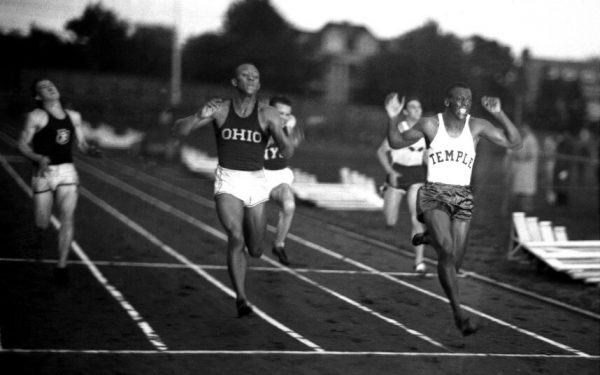
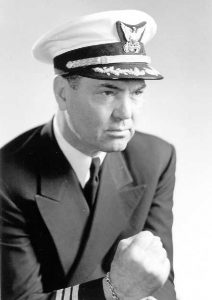
Former heavyweight champion of the world Jack Dempsey, who just received a promotion to lieutenant commander, serves as the Manhattan Beach Coast Guard Station’s Director of Physical Education. One newspaper writer referred to Dempsey as the Depth Bombers’ “water boy,” but surely he is joking. With Jack Dempsey on the sidelines and the man who beat Jesse Owens on the field, it’s no wonder Brooklyn (No. 9) is two spots ahead of Second Air Force (No. 11) in an AP poll of service teams published earlier this month… Speaking of boxers, retired lightweight, light-welterweight, and welterweight world boxing champion and Marine corporal Barney Ross is in the news again. This time he has been named boxing’s man of the year. Last month we reported that Ross had earned the Silver Star for a heroic stand on Guadalcanal.
Roving Reporter by Ernie Pyle
WITH THE AMERICAN FORCES IN ALGERIA — Our troopship in convoy from England to Africa had a large hospital, and it was filled.
The long train rides in unheated cars across England seemed to give everybody a cold, and it was a poor man indeed who couldn’t sport a deathlike cough aboard ship.
We had two pneumonia cases, both of whom pulled through. I myself came down with one of the Ten Best Colds of 1942 the day after we got aboard, and spent the next five days in bed feigning seasickness.
But the ship was lousy with Army doctors, so I had lozenges, injections and consultations, all without charge.
Our ship had never carried American troops before, and the British waiters were somewhat shocked by the appetites and the diningroom manners of the younger officers.
Second lieutenants, muscular and still growing, would order a complete second dinner after finishing the first. And in between times they’d get up and serve themselves with bread, carry off their own plates, play loud tunes on their glasses with their forks, make rude jokes about the food, and generally conduct themselves in a manner unbecoming of the dignity of a British cruise-ship waiter.
But I must say, in behalf of the British, that they finally broke down and entered into the spirit of the thing, and I think eventually enjoyed the Wild West camaraderie as much as the Americans did.
Those of us in the cabins were awakened at 7 each morning by the cabin steward, bearing cups of hot tea. Meals were in two sittings, an hour apart. The headwaiter wore a tuxedo at dinnertime, and the food was excellent.
We had fried eggs and real bacon for breakfast every morning — the first real egg I’d tasted in four months. There was also tea in the after noon, and sandwiches at night.
Smoking was prohibited in the dining room. The British waiters had a terrible time enforcing it, but finally succeeded. Apparently it was just an old British custom.
There was a bar in the evening for soft drinks, but no liquor was sold. Some officers brought whisky aboard, and from then on it was probably the driest ocean voyage ever made.
As someone wisecracked, “We catch it both ways. We can’t smoke in the dining room because it’s a British ship, and we can’t buy liquor because it’s an American trooper.”
Of all the spots on earth where rumors run wild, I think a convoy trooper must lead, hands down. Scores of rumors a day floated about the ship. You got so you believed them all, or didn’t believe any.
It was rumored we would rendezvous with a big convoy from America; that and aircraft carrier had joined us; that we’d hit Gibraltar in six hours, 24 hours, two days; that the ship behind us was the West Point, the Mt. Vernon, the Monterey; that we were 80 miles off Portugal, and 200 miles off Bermuda. None of these turned out to be true.
The rumor-mongering got so rife that one officer made up a rumor to the effect that we were going to Casablanca and timed it to see just how long it would take to encircle the ship. It came back to him, as cold fact right from the bridge, in just half an hour.
The third day out we correspondents decided to start a daily paper. The colonel was all for it, and helped us round up paper and stencils. We published for four days and then ran out of stencils and had to suspend. Sgt. Bob Nevile, of The Stars & Stripes, did most of the work. We carried the radio news each day, a little shipboard gossip column, a daily “exploded rumor” department, and some silly pieces by us correspondents.
Since we were not allowed to use the ship’s real name, the paper was called “The P-58 Post,” as that was our designated number in the convoy. Beneath the masthead was carried a motto, “All the Rumors Fit to Print.”
There was an unconfirmed rumor about the ship that it was a fairly lousy paper.
Evening star. (Washington, D.C.), 21 December 1942. Chronicling America: Historic American Newspapers. Lib. of Congress.
https://chroniclingamerica.loc.gov/lccn/sn83045462/1942-12-21/ed-1/
